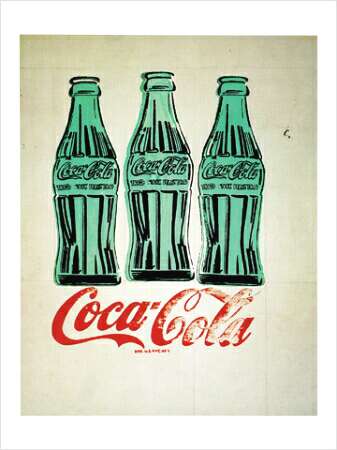The commercialization and entertainmentization of art museums continues. The High Museum in Atlanta just stooped to mounting an exhibit titled The Coca-Cola Bottle: An American Icon at 100. Â Atlanta is the birthplace of Coca-Cola and the company is probably a major benefactor of many organizations, including the High, in Atlanta. But still.
 I could not find, in a fairly quick search, how much money Coke gives to the High. But it may be substantial. Interestingly, the “vice chair-exhibitions” of the High’s board of trustees is Michael Keough, son of the recently deceased Donald R. Keough, the onetime president and COO of Coke.
I could not find, in a fairly quick search, how much money Coke gives to the High. But it may be substantial. Interestingly, the “vice chair-exhibitions” of the High’s board of trustees is Michael Keough, son of the recently deceased Donald R. Keough, the onetime president and COO of Coke.
Neither one is a proper rationale for mounting this exhibition.
It’s true that the Coke bottle has inspired, say, Andy Warhol. His silkscreen, Three Coke Bottles, from 1962, is in the exhibit (and at left). So are photographs of Ansel Adams in a Truck, Yosemite Valley, 1953, by Imogen Cunningham, in which he’s drinking from a coke bottle, and Alfred Eisenstaedt’s Little Boy Selling Coca-Cola at Roadside, Atlanta, Ga., 1936, to name a few more. The company lent several of the items, in fact.
And Coke is making much of the show: its website has an article about it, with an interview with the curator; a video of the exhibit’s opening night; a story citing “five highlights” of the exhibit (through its eyes); and an “image library.” Â And the exhibit opened only on Saturday: who knows what will come next.
Too, the High is getting a lot of publicity for the show. An Associated Press story, distributed on Feb. 26, was picked up by the Boston Globe, the Seattle Times, the San Jose Mercury-News, the Delaware News Journal, ABC News and Canada.com–to name those I noticed.
Here’s a link to the piece in the Seattle Times, in which the bottle is called “a design success story.”
The exhibition walks visitors through the history of the bottle’s design, which was conceived as a way to distinguish Coca-Cola from a multitude of imitators.
In a 1915 memo, the company asked glass companies to come up with “a bottle which a person could recognize even if they felt it in the dark, and so shaped that, even if broken, a person could tell at a glance what it was.â€
…Opposite a display of Coca-Cola bottles through the years are two dozen posters by contemporary designers created in response to an invitation from Coca-Cola last year to imagine the next century.
Etc. This is way too commercial for my taste.
In fact, I have to wonder if the High is embarrassed by the exhibit. It’s interesting that, earlier this year, when I began compiling exhibition listings for the upcoming New York Times Museums section, I asked it (and dozens of other art museums) for the schedule of exhibitions that would be on view at least through April and, especially those opening between March and August. On the list submitted to me, the High did not mention the Coke show, which opened on Feb 28 and runs through Oct. 4.
The High did, however, include Gordon Parks: The Segregation Story, which opened last Nov. 15 and continues through June 21. And it included Wifredo Lam: Imagining New Worlds (Feb. 14 through May 24) and Earl Pardon’s “Portable Art”: Jewelry and Design (Jan. 31 through June 7), as well as several other exhibits.
Why not Coke?
